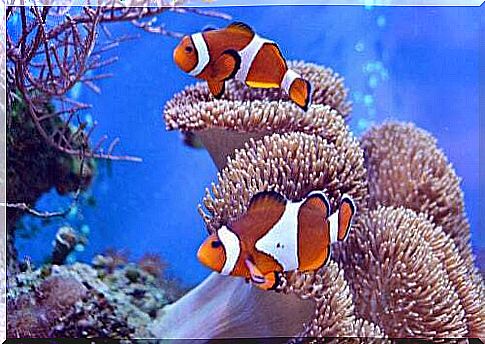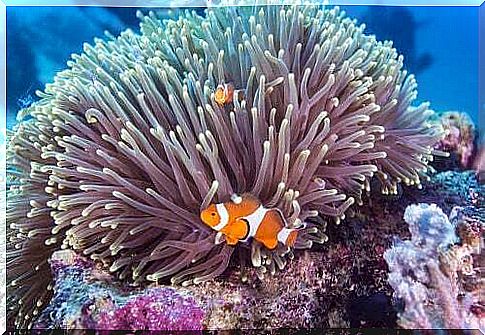The Incredible Relationship Between The Clownfish And The Sea Anemone

Clownfish is a marine fish whose scientific name is Amphiprion ocellaris . It is also called anemone fish because it lives in sea anemones, with which it maintains a very close and particular relationship. Let’s see together the relationship between the clown fish and the sea anemone.
This curious marine specimen is known for the famous animated film In search of Nemo : the protagonist, precisely Nemo, belongs to this species. In this article, we will look at some features to learn more about this fantastic specimen, a favorite of aquarium enthusiasts. Let’s talk about the relationship between the clownfish and the sea anemone.
Physical characteristics and distribution of the clown fish
Without a doubt, the clownfish’s best-known feature is its incredible bright orange color. In fact, this hue varies from yellow to orange brown. It also has white stripes around the body – usually three – surrounded by very thin black stripes. The fins have a black border.
Clownfish usually range in length from 9 to 11 centimeters. The dominant female is the largest. A very curious feature of these fish is that all specimens are born males. The older male has the ability to become a female to assume the dominant role of the group. This process is irreversible.
Like all pomacentrids, most known clownfish species live in the shallow coral reefs of the Indian Ocean, Red Sea, and Western Pacific. This type of fish is not found in the Mediterranean, the Caribbean or the Atlantic.
Sea anemones are home to clown fish
Sea anemones are marine predators that have very colorful and poisonous tentacles. One of the most characteristic aspects of the clownfish is that it lives, shelters, reproduces and even feeds surrounded by anemones. The relationship between the clown fish and the anemones is very particular and symbiotic: it is an indissoluble combination.

When choosing a sea anemone, the clownfish performs a very special dance with this marine animal : it rubs gently on the tentacles with different parts of the body in order to accustom it to its presence.
Once it has chosen its home, this curious fish supplies the anemones with nutrients through its fecal matter and keeps them protected from butterfly fish, which usually feed on their tentacles.
The sea anemone feeds on fish. However, the mucous layer that covers the clownfish’s skin offers protection that makes them immune to its lethal sting. The relationship of trust and help between these two species is so powerful that the clownfish lays its eggs at the base of the anemone’s tentacles.
A relationship with mutual benefits
While the clownfish and sea anemone relationship is not an addictive relationship, their lives are much easier when they are together.
It is true that they can live without each other: the clownfish would not die without the anemones and the anemones would not die without the clownfish. However, the relationship brings them great mutual benefits. This relationship between the two species is called mutualism.

These two species maintain a relationship that guarantees mutual protection and which is truly special in the marine world. The fish protects the anemone from other possible predators and prevents it from suffering from infections by cleaning it of possible parasites. In return, anemones offer the clownfish not only a home, but also protection against predators.
In fact, with its bright colors, the clownfish is one of the favorite victims of many marine predators. Anemones offer this fish a chance to survive in a marine world that can be very hostile without them. For this reason, sea anemones are undoubtedly the best allies of the clownfish.
Oxygenation and photosynthesis
In this symbiotic relationship, the clownfish gives the anemone another key benefit: it supplies oxygen to its tentacles by swimming around them.
Indeed, coral reefs are full of oxygen during the day, but during the night these levels can drop considerably as photosynthesis stops. In this way, the fish causes the anemone’s tentacles to expand with its fins, which helps the animal to breathe.
The clownfish and the sea anemone are examples of how two different species can not only live together in a close space, but also offer each other mutual help, which is also vital for their survival.









